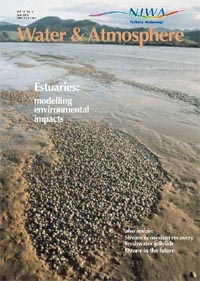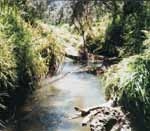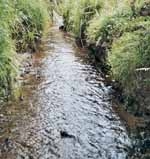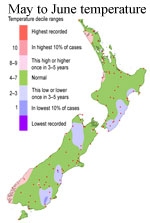PDF of this article (1 MB)

Jody Richardson
Bankside and overhanging vegetation not only provides shelter for fish; it also helps a stream to form diverse habitat.
Inanga are one of five galaxiid species that make up the whitebait catch, and in most rivers and streams they form the bulk of the catch. After they have migrated from the sea in spring, inanga spend about six months growing to maturity in fresh water. We have discovered through our ongoing whitebait research programme that mortality rates during this freshwater maturation stage are very high (see Water & Atmosphere 8(2): 6–7). Because of this, we are focusing our work on the causes of mortality and ways to reduce it, including the role of stream cover.
We have always assumed that fish need places to shelter from predators and high water velocities; therefore re-establishing cover is often one of the key objectives of stream restoration projects. But how important is cover for a fish that lives in mid-water and feeds out in the open? To find out we looked at the influence of cover on the inanga population in a small stream. Our results show that cover not only provides shelter, but is also the foundation for habitat in small streams, particularly the pool habitat favoured by inanga.
What we did


We did not have enough time to re-establish cover on a bare stream, so we decided to remove the cover from a stream that we already knew provided a good habitat for inanga. This stream is a small tributary of the Mokau River on the North Island’s west coast, north of New Plymouth, and was previously used to collect measurements of mortality rates during the freshwater maturation stage.
The study stream enters the main stem about 6 km upstream from the sea. It is only about 1.5 m wide and is cut into 1-m high banks. About 400 m upstream of the limit of tidal influence is a 7-m-high waterfall that prevents inanga from moving farther upstream. Although the surrounding area is in pasture, there is still a good riparian strip of manuka and gorse, and plenty of bank-side vegetation overhanging the stream. Small, woody debris is also a feature of the instream cover.
In November 2001 we removed the cover from five 15-m-long reaches of the stream by clipping off all the bank-side vegetation, removing all the woody debris, and cutting back any overhanging banks. We left the larger trees on top of the banks, but removed any overhanging branches. Any re-forming cover was removed during subsequent visits. We also established five 15-m-long reaches and left them in their natural state. These reaches were adjacent to the cleared reaches, but separated from them by small riffles.
We used electric fishing methods to assess the fish population at monthly intervals beginning in December 2001. Stop nets were placed at the bottom and top of each reach to prevent fish from escaping, and multiple electric fishing passes were carried out until there was at least a 50% reduction in the catch of inanga compared with the previous pass. We identified all the fish caught to species, then measured them and released them into the reach where they were caught. For each reach, the inanga population density – number of fish per metre of stream length fished – was calculated. Data from the cleared reaches were combined for a comparison with the data from the natural reaches.
In January 2002 we conducted a single habitat survey of the stream by measuring the water depth and velocity at four cross-sections in each of the cleared and natural reaches. We also visually assessed the substrate composition, then combined the cross-section data from the cleared and natural reaches to compare the physical characteristics of the reaches.
What we found

Although we had not measured water depth and velocity in the cleared reaches before removing the cover, we assumed they were similar to those in the natural reaches. After the first month we noticed that removing the cover had affected the stream habitat. The cleared reaches were shallower, swifter and narrower than the untouched reaches, although the differences were statistically significant only for depth. This meant that the deep, wide and slow-flowing habitat (i.e., pools) disappeared when the reach was cleared.
In this small stream, and probably in many others like it, the pools are usually formed by clusters of woody debris that cause the water to back up and create deep, slow-flowing water. The slow water provides shelter from the current while the overhanging vegetation provides shelter from predators. However, when the debris is removed, the pools disappear. As well as providing overhead cover, bank vegetation also helps protect habitat structure. When the flow increases, vegetation slows the water current, preventing the movement of bed substrate and helping to maintain the habitat structure. With no debris in the stream and no bank vegetation, high flows have more impact and can cause the reach to become homogeneous and featureless by smoothing out the substrate and infilling any deep spots. The result is no cover – and no habitat for the fish.
Our results showed that there were more inanga in reaches left in their natural condition than in those that were cleared (see graph). This supports our other studies, which have shown that pools are important feeding habitats for inanga. We attribute the anomalous result for December to the large flood the week before our measurements which may have redistributed the fish throughout the stream.
Low mortality
We did not record a high mortality rate of maturing fish this year. The reasons for this are unclear, but it could be because of unusually high rainfall in summer 2001/2002. We will continue to monitor the population until the autumn spawning migration begins. If the mortality rate remains low, then there are prospects for a good year for egg production and, we hope, a large whitebait run next season.
Stream cover plays an extremely important role in providing habitat for inanga. If we want to increase whitebait runs in the long term then we need to allow streams that are suitable for inanga (i.e., low gradient and close to the coast) to return to a more natural state. Usually this simply requires the exclusion of livestock and some time.
Teachers: this article can be used for Biology L7 A.O. 7.1a. See other curriculum connections at www.niwa.co.nz/pubs/wa/resources
Jody Richardson is based at NIWA in Hamilton.
Restoring habitat for inanga: a guide
NIWA has just produced a comprehensive guide for restoring inanga habitat. “A guide to restoring inanga habitat” (NIWA Science & Technology Series No. 50) gives examples and explanations of suitable inanga streams and how to restore them, and also discusses the location and protection of the estuarine spawning sites that inanga use. See the NIWA whitebait web pages (www.niwa.co.nz/rc/prog/whitebait/) for further information.
